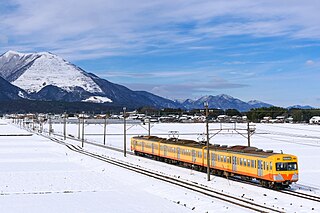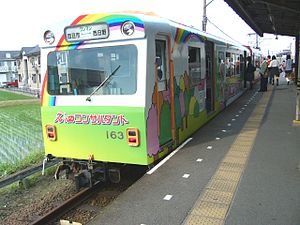
A narrow-gauge railway is a railway with a track gauge narrower than 1,435 mmstandard gauge. Most narrow-gauge railways are between 600 mm and 1,067 mm.

The Nagoya Line is a railway line owned and operated by the Kintetsu Railway, a Japanese private railway company, connecting Nagoya and Ise Nakagawa Station in Matsusaka, Mie Prefecture via Kuwana, Yokkaichi, Suzuka, Tsu municipalities along the Ise Bay. The official starting-point of the line is Ise-Nakagawa and the terminus is Nagoya; however, operationally trains run "down" from and "up" towards Nagoya.

The Tōhoku Main Line is a 575.7-kilometre-long (357.7 mi) railway line in Japan operated by the East Japan Railway Company. The line starts from Tokyo Station in Chiyoda, Tokyo and passes through such cities as Saitama, Utsunomiya, Fukushima, and Sendai, before reaching the end of the line in Morioka. The line originally extended to Aomori, but was truncated upon the extension of the Tōhoku Shinkansen beyond Morioka, which mostly parallels the Tōhoku Main Line. A portion of the Tōhoku Main Line is also shared with the Keihin–Tōhoku Line and the Saikyō Line.

Rail transport in Taiwan consists of 2,025 kilometres (1,258 mi) of railway networks. Though no longer as dominant as it once was, rail transport is an extremely important form of transportation in Taiwan due to high population density, especially along the densely populated western corridor. In 2016, over 1.09 billion passengers traveled by rail in Taiwan, averaging 2.99 million passengers per day.

With railways, a break of gauge occurs where a line of one track gauge meets a line of a different gauge. Trains and rolling stock generally cannot run through without some form of conversion between gauges, leading to passengers having to change trains and freight requiring transloading or transshipping; this can add delays, costs, and inconvenience to travel on such a route.

The Ōu Main Line is a railway line in Japan, operated by the East Japan Railway Company. It connects Fukushima Station through Akita Station to Aomori Station. Since the opening of the Yamagata Shinkansen on July 1, 1992, the Fukushima–Yamagata section is sometimes referred to as the Yamagata Line. The name of the line as a whole refers to the ancient provinces of Mutsu (陸奥) and Dewa (出羽), as it connects both ends of Mutsu by passing north–south through Dewa.

The Yokkaichi Asunarou Railway Utsube Line is a 762 mm narrow gauge railway line operated by the Japanese private railway company Yokkaichi Asunarou Railway, connecting Asunarou Yokkaichi Station and Utsube Station, both in the city of Yokkaichi, Mie, Japan.

The Yokkaichi Asunarou Railway Hachiōji Line is a 762 mm narrow gauge railway line operated by the Japanese private railway company Yokkaichi Asunarou Railway, connecting Hinaga Station and Nishihino Station, both in the city of Yokkaichi, Mie, Japan. It extends for a total length of 1.3 kilometres (0.81 mi).

Bogie exchange is a system for operating railway wagons on two or more gauges to overcome difference in the track gauge. To perform a bogie exchange, a car is converted from one gauge to another by removing the bogies or trucks, and installing a new bogie with differently spaced wheels. It is generally limited to wagons and carriages, though the bogies on diesel locomotives can be exchanged if enough time is available.

Sangi Railway Co., Ltd. is a private railway company in Mie Prefecture, Japan, which also operates bus lines. The company was founded in 1928 and its initial line, the Sangi Line, originally functioned as a freight line transporting cement, but later developed into an important commuter railway line for Yokkaichi. The Hokusei Line was transferred from Kintetsu ownership in 2003 when Kintetsu abandoned the line. Whereas the Sangi Line has a track gauge of 1,067 mm, the Hokusei Line is one of only a few 762 mm narrow gauge lines remaining in the country.

The Yunoyama Line is a railway line of the Japanese private railway company Kintetsu Railway, connecting Kintetsu-Yokkaichi Station and Yunoyama-Onsen Station in Japan.

The Hokusei Line, commonly known as the Sangi Hokusei Line, is a 762 mm narrow gauge railway line owned and operated by Sangi Railway, a Japanese private railway company. The line runs in Mie Prefecture an connects Nishi-Kuwana Station in Kuwana with Ageki Station in Inabe. For many years, the line was owned by Kintetsu, a major private railway operator, but control was transferred to Sangi in April 2003.

The Tobu Kiryu Line is a railway line in Japan operated by the major private railway operator Tobu Railway. The line is a 20.3 km (12.6 mi) branch off the Isesaki Line at Ōta Station, southbound to Akagi Station.

The vast majority of North American railroads are standard gauge. Exceptions include some streetcar, subway and rapid transit systems, mining and tunneling operations, and some narrow-gauge lines particularly in the west, e.g. the isolated White Pass and Yukon Route system, and the former Newfoundland Railway.

The Railway Company of the Congo was a narrow gauge railway company in the Congo, which built and operated the Matadi–Kinshasa Railway initially with a gauge of 750 mm.

Sweden once had some fairly extensive narrow-gauge networks, but most narrow-gauge railways are now closed. Some were physically converted to 1,435 mmstandard gauge and some remain as heritage railways. The most common narrow gauge, 891 mm, exists only in Sweden. A smaller 3 ft 6 in gauge network existed, and 600 mm gauge was used mostly by smaller, industrial railways. Still other but lesser used gauges in the country were 693 mm, 802 mm, 1,099 mm, 1,188 mm and 1,217 mm, all converted or removed.
Europe inherited a diversity of rail gauges. Extensive narrow-gauge railway networks exist in Spain, Central Europe and Southeastern Europe.
Asia has many narrow-gauge railways. The railways of Japan, Indonesia and the Philippines are predominantly 1,067 mm narrow gauge. Those in mainland Southeast Asia, which includes Vietnam, Cambodia, Laos, Thailand, Myanmar and Malaysia, are predominantly metre gauge. The proposed ASEAN Railway would be standard or dual gauge, using metre- and standard-gauge regional railway networks and linking Singapore through Malaysia, Thailand, Laos and Vietnam to China's standard-gauge rail network. In Western Asia, Jordan uses 1,050 mm narrow gauge.
Numerous narrow-gauge railway lines were built in Oceania, most in 3 ft 6 in, 2 ft 6 in and 2 ft track gauge.

Yokkaichi Asunarou Railway is a third-sector railway company in Yokkaichi, Mie, Japan. The company is 75% owned by Kintetsu Railway and 25% owned by the city government of Yokkaichi.

















